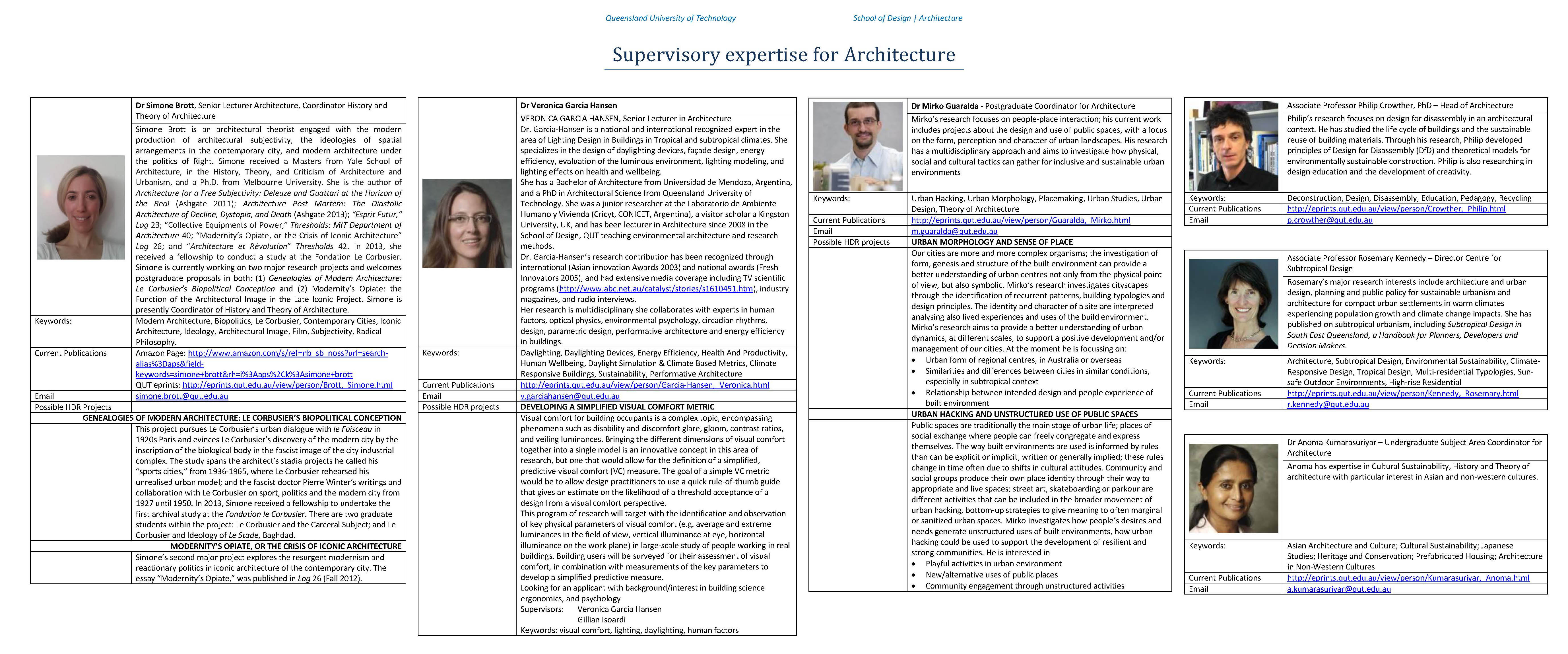University of Oklahoma
The Division of Architecture (DivA) recently appointed the following faculty as new administrative positions: Marjorie P. Callahan as Associate Director of Faculty Development, Anthony Cricchio as Associate Director of Curriculum Development, and Dr. Stephanie Pilat as Associate Director of Student Development.
Associate Professor of Architecture Marjorie P. Callahan, AIA received an Ed Cline Faculty Development Award Spring 2014. The award funded research conducted at Carnegie Mellon University with noted scholar Dr. Omer Akin exploring how University environments shape teaching and learning. Marjorie was recently appointed the in-house IDP Education Coordinator and advisor to the newly formed DivA student organization Architectural Virtuosi, a student organization focused on assisting students through the IDP process.
In association with the Bruce Goff Chair of Creative Architecture, Assistant Professor Dr. Catherine Barrett, AIA is chairing the 2014 Creating_Making Forum, November 5-7. This year’s forum builds upon the discourse introduced at the inaugural 2010 Creating_Making Forum. Featured speakers include Dr. Robert Fishman, OU DivA Director Hans Butzer, and Andrew Freear. For more info, visit: http://www.ou.edu/architecture/centers/creating-making.html
Associate Professor David Boeck, AIA and Assistant Professor Dr. John Harris (Division of Regional and City Planning) led a student service-learning initiative to Zambia, Africa Summer 2014. David also gave a presentation titled Aging in Place to a group of senior citizens in Stillwater, Oklahoma September 2014. As advisor to the College of Architecture (CoA) student organization NOMAS, David escorted the student competition team to Philadelphia for the 42nd Annual NOMAS Conference.
Assistant Professor Daniel Butko, AIA collaborated with Russ Berger Design Group (RBDG) Summer 2014 on a variety of acoustical design projects including a 7,000 sf multi-studio facility. Daniel’s ongoing research with RBDG has shaped his professional and academic investigations, including the curriculum for his biannual Architectural Acoustics seminar titled The Sound of Shaped Space. As a member of the OU CoA Compressed Earth Block (CEB) Research team, Daniel is currently collecting thermal, energy, and acoustical data from both recently completed CEB and adjacent wood-framed residences. Daniel will present conclusions based on recent data in a paper presentation at the Acoustical Society of America (ASA) conference October 2014. Daniel continues his role as advisor to the CoA student organization Design-Build Society (DBS) as they prepare for their first community-based service-learning project of the 2014/15 AY. As part of the DivA’s Bridging Cultures Program, Daniel led a three-day visit to Kansas City, MO September 2014 for the 4th year Undergraduate and 3rd year Graduate students. The group of 46 students and 3 faculty toured numerous firms, buildings, and site options for the semester mixed-use design project.
Director Hans Butzer, AIA through his practice Butzer Gardner Architects recently published the North Downtown Redevelopment Plan for Oklahoma City. The plan explores the relationship of development opportunities with transportation improvements including streetcar routes and a bicycle boulevard. Hans also lectured at the Oklahoma District Council of the Urban Land Institute.
Associate Professor Anthony Cricchio, RA was promoted to Associate Professor upon receiving tenure. Anthony also serves as Coordinator of College of Architecture International Programs, overseeing bridging cultures experiences.
Associate professors Anthony Cricchio, RA and Nickolas Harm, RA were instructors for the annual Playhouse Parade project in which students design and build a playhouse for CASA (Court Appointed Special Advocates) of Oklahoma County. This is the fifth year CoA students have designed and constructed a playhouse for CASA’s raffle to raise support for local children in need. The collaborative course included 8 students of various year levels, Building Facility Manager Jerry Puckett, and Creating_Making Lab Manager Hunter Roth.
Associate Professor Lee Fithian, AIA joined with Associate Tammy McCuen (Division of Construction Science) as advisors to the third place team at the National Design-Build Institute of America (DBIA) annual student competition October 2014. Lee recently returned with an interdisciplinary group of students as part of the Spring 2014 semester Rome Program. Lee and her CoA students collaborated with an Italian elementary school to design and construct a rainwater collection system as the service-learning component of this annual bridging cultures experience. Professor Nickolas Harm and 20 students from the Divisions of Architecture and Interior Design are preparing for the Spring 2015 semester in Rome.
The CoA Institute for Quality Communities hosted Oklahoma’s 26th Annual Statewide Preservation Conference in June under direction of Wic Cary Professor and Director of Small Town Studios, Associate Professor Ron Frantz, AIA. Ron was also a speaker during the conference. For more information, visit http://okpreservationconference.wordpress.com
Assistant Professor Dr. Stephanie Pilat completed the book titled “Reconstructing Italy: The Ina-Casa Neighborhoods of the Postwar Era.” This book, published by Ashgate Publishing Limited, traces the transformation of the Italian nation through an analysis of the Ina-Casa plan for working-class housing, established in 1949 to address the employment and housing crises. As a recipient of the Wolfsonian-FIU Fellowship, Stephanie conducted research in residence on a new project titled “Shaping the Body Politic: Architecture for Youth and Sports in Fascist Italy.” Stephanie is also the recipient of The University of Oklahoma, CoA 2014 Outstanding Educator Award.
Joining the DivA faculty Fall 2014 are Assistant Professor Dr. Shideh Shadrahan to lead instruction on structural design in architecture, Assistant Professor Bob Pavlik, AIA to shape pedagogical strategies for digital haptic fabrication techniques and beginning design, and Associate Professor Jay Yowell to enhance the integration of sustainability and ethics in design and systems courses. Award winning practitioners Debra Richards, AIA and Geoff Parker, AIA serve as adjunct faculty for the 2014/15 AY.
In other program news, the CoA is now offering a PhD in Planning, Design, and Construction as of Fall 2014. The CoA recently awarded over $110,000 in 40 scholarships to 90 students from all disciplines (Architecture, Construction Science, Interior Design, Landscape Architecture, Regional & City Planning, the Tulsa Urban Design Studio, and Environmental Design). The CoA also recently honored Academic Counselor Suzanne Robinson with OU CoA 2014 Jerri Hodges Bonebrake Award, named after Bruce Goff’s long-time assistant.

 Study Architecture
Study Architecture  ProPEL
ProPEL 

